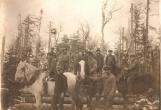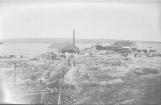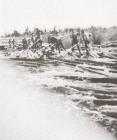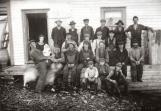1
Boiler at French's Pointcirca 1903
Birchy Bay, Newfoundland & Labrador, Canada
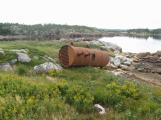 Credits:
Credits:Desmond Canning
2
In the early days with only temporary settlement the men and their families would come into Birchy Bay to seek shelter from the harsh elements. During the winters endless chill the men would log and manufacture lumber by hand. First they would cut the logs and haul them either by the aid of a horse of sometimes just by manpower. They would bring them to a pit saw. One man would get on top and the other would get on bottom each holding different ends of the saw. One man would use a mixture of ochre to apply to the log similar to today's chalk line so the men would know where to cut to get even planks from the logs. Then they would dress the planks with hand planes. Then they would match the lumber together. This process was very tedious and was all done by hand.3
Birchy Bay was well known for its beautiful stands of timber. Rising up from the beaches grew birch, pine and spruce. They gently rose over the slopes of Birchy Bay beyond the hills following the rocky shores of Jumpers brook inland to its ponds, rattles and winding steadies. Here grew a forest that many men in them days called virgin forest, meaning untouched by the scarring hands of man. These forests were the lure of the early settlers procuring from the wooded hills logs to be sawn into lumber to build boats and various buildings and articles to be brought back to Barr'd Islands.4
But there was a greater venture still yet to come and Jumpers brook was the means to getting to it all. This caught the interest of two men from the New World Island Area, James and Thomas French two brothers with great aspirations. In 1901 they began construction on a steam propelled mill at the mouth of Jumpers Brook. This was a highway which would link the sawmill to the vast inland sources. After the tree's had been cut, trimmed, and cut into logs they could be hauled out onto the ice for spring thaw also known as the faeshet. With the rapid increase of water the logs would travel their selves out the brook to the mouth where it empties into the salt water. The logs were hauled up to be feed into the mill. The French's mill employed every able bodied man twelve years and up. So there were up to twenty two men employed at times. They hired more men on when there was a towing job to do according to the Late Ambrose Osmond.8
There was no loggers union at that time but the company did not escape labour trouble. The loggers were former fisherman, all of whom were members of the fisherman's protective union. On one occasion the loggers staged a strike to protest poor working conditions. They were working on the drive in the long days of May, from daylight to dark, leaving them with little time to dry their wet clothes and to get sufficient rest. The hard work produced big appetite, and bread was the main bulk of their food. The bread was palatable as long as the butter was good. When their problem was compounded by a batch of bad butter, the men decided to take action. All but one of the loggers and the foreman left their jobs and walked out of the woods.When the loggers converged on the mill work site, the manager, William French, with his brother Alfred the Millwright, were supervising an extension on the wharf, and the men were bringing in ballast in an old boat that had to be kept afloat by constant bailing.
The manager left his work and thought to end the strike quickly by firing the leader. His brother was sympathetic to the labour movement, and has a greater appreciation for union solidarity, intervened to warm his brother that if he fired their leader (Richard Osmond) all the men would quit. Because they depended much on the spring faeshet-(the water from melting snow running into the brook that carried the logs to the mill), a prolonged work stoppage would seriously interfere with their work. The manager recognized the wisdom of such advice and decided to negotiate with the men. When he heard their complaint, he too was sympathetic to their cause, and an agreement was quickly reached.
The next morning the men returned to their work with a letter to the foreman advising him to limit the work day to twelve hours, and they carried back good butter in their knapsacks. The men, who had been bringing ballast to the wharf, left their work expecting to hear a good row. When it was over they returned to find their boat had gone to the bottom of the sea with its load of rocks.
9
Loading LumberEarly 1900's
Birchy Bay, Newfoundland & Labrador, Canada
 Credits:
Credits:Reflections of Birchy Bay, Allan Quinlan
10
In the year 1910 a forest fire rampage much of the area around Birchy Bay. This fire depleted much of the good timber for many lumber companies around. Due to logging leases the Birchy Bay Lumber Company was only allowed to log within a three mile limit and the steam powered mill was not be able to sustain itself. So eventually it was shut down and replaced by a small gas propelled mill which was owned and operated by Alfred French.With the sawmill closed down many of the men in Birchy Bay had to look for work elsewhere. The men who were once fisherman were now loggers and they did not want to turn back to the sea for livelihood. Many of the people In Birchy Bay went to work with the Anglo Newfoundland Development Company or as many call it the A.N.D Co. These men were skilled loggers and it did not take long for their skills to show while working with the A.N.D Co.
With the A.N.D Co. came higher wages. Allan Quinlan explains in his book reflections of Birchy Bay "In the twenties two young men from Birchy Bay, Ambrose Osmond, and Peter Quinlan, were the first to make $5.00 a day cutting wood on price work with the Millertown division of the A.N.D Co. Prior to the great depression, the price of wood rose from $2.00 to $3.00 per cord, depending on the quality of timber. In 1933 the price of wood was slashed by fifty percent".
The men of Birchy Bay proved themselves well on a log. Thomas Canning the son of the Pioneer John Canning exceeded through with the A.N.D Company. As well His brother Walter was known as a big strong man and able to lift logs like a bear. The youngest brother was known to be quick on the log and was reputed to be the smartest man on the Bishop Falls division of the A.N.D Co.
11
Logging At Jumpers Brook-Bay of Exploits20th Century
Jumpers brook, Bay of Exploits, Newfoundland & Labrador, Canada
